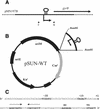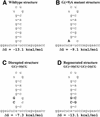A hairpin near the 5' end stabilises the DNA gyrase mRNA in Mycobacterium smegmatis
- PMID: 12490705
- PMCID: PMC140080
- DOI: 10.1093/nar/gkf697
A hairpin near the 5' end stabilises the DNA gyrase mRNA in Mycobacterium smegmatis
Abstract
RNA is amongst the most labile macromolecules present in the cells. The steady-state levels of mRNA are regulated both at the stages of synthesis and degradation. Recent work in Escherichia coli suggests that controlling the rate of degradation is as important as the process of synthesis. The stability of mRNA is probably more important in slow- growing organisms like mycobacteria. Here, we present our analysis of the cis elements that determine the stability of the DNA gyrase message in Mycobacterium smegmatis. The message appears to be stabilised by a structure close to its 5' end. The effect is especially pronounced in a nutrient-depleted state. These results largely parallel the model proposed in E.coli for mRNA degradation/ stability with subtle differences. Furthermore, these results suggest that the slow-growing organisms might use stable mRNAs as a method to reduce the load of transcription on the cell.
Figures





Similar articles
-
Regulation of DNA gyrase operon in Mycobacterium smegmatis: a distinct mechanism of relaxation stimulated transcription.Genes Cells. 1999 Dec;4(12):697-706. doi: 10.1046/j.1365-2443.1999.00296.x. Genes Cells. 1999. PMID: 10620015
-
Importance of a 5' stem-loop for longevity of papA mRNA in Escherichia coli.J Bacteriol. 1999 Jun;181(11):3587-90. doi: 10.1128/JB.181.11.3587-3590.1999. J Bacteriol. 1999. PMID: 10348874 Free PMC article.
-
An evolutionarily conserved RNA stem-loop functions as a sensor that directs feedback regulation of RNase E gene expression.Genes Dev. 2000 May 15;14(10):1249-60. Genes Dev. 2000. PMID: 10817759 Free PMC article.
-
Translation initiation and the fate of bacterial mRNAs.FEMS Microbiol Rev. 2006 Nov;30(6):967-79. doi: 10.1111/j.1574-6976.2006.00043.x. Epub 2006 Sep 21. FEMS Microbiol Rev. 2006. PMID: 16989654 Review.
-
The role of mRNA and protein stability in gene expression.FASEB J. 1989 Oct;3(12):2360-70. doi: 10.1096/fasebj.3.12.2676679. FASEB J. 1989. PMID: 2676679 Review.
Cited by
-
Natural environmental water sources in endemic regions of northeastern Brazil are potential reservoirs of viable Mycobacterium leprae.Mem Inst Oswaldo Cruz. 2017 Dec;112(12):805-811. doi: 10.1590/0074-02760170117. Mem Inst Oswaldo Cruz. 2017. PMID: 29211240 Free PMC article.
-
Regulation of mRNA Stability During Bacterial Stress Responses.Front Microbiol. 2020 Sep 9;11:2111. doi: 10.3389/fmicb.2020.02111. eCollection 2020. Front Microbiol. 2020. PMID: 33013770 Free PMC article. Review.
-
The katG mRNA of Mycobacterium tuberculosis and Mycobacterium smegmatis is processed at its 5' end and is stabilized by both a polypurine sequence and translation initiation.BMC Mol Biol. 2008 Apr 4;9:33. doi: 10.1186/1471-2199-9-33. BMC Mol Biol. 2008. PMID: 18394163 Free PMC article.
-
Terminal hairpins improve protein expression in IRES-initiated mRNA in the absence of a cap and polyadenylated tail.Gene Ther. 2023 Aug;30(7-8):620-627. doi: 10.1038/s41434-023-00391-4. Epub 2023 Feb 24. Gene Ther. 2023. PMID: 36828937 Free PMC article.
-
Specificity and evolutionary conservation of the Escherichia coli RNA pyrophosphohydrolase RppH.J Biol Chem. 2015 Apr 10;290(15):9478-86. doi: 10.1074/jbc.M114.634659. Epub 2015 Feb 5. J Biol Chem. 2015. PMID: 25657006 Free PMC article.
References
-
- Rauhut R. and Klug,G. (1999) mRNA degradation in bacteria. FEMS Microbiol. Rev., 23, 353–370. - PubMed
-
- Regnier P. and Arraiano,C.M. (2000) Degradation of mRNA in bacteria: emergence of ubiquitous features. Bioessays, 22, 235–244. - PubMed
-
- Grunberg-Manago M. (1999) Messenger RNA stability and its role in control of gene expression in bacteria and phages. Annu. Rev. Genet., 33, 193–227. - PubMed
-
- Deutscher M.P. and Li,Z. (2001) Exoribonucleases and their multiple roles in RNA metabolism. Prog. Nucleic Acid Res. Mol. Biol., 66, 67–105. - PubMed

